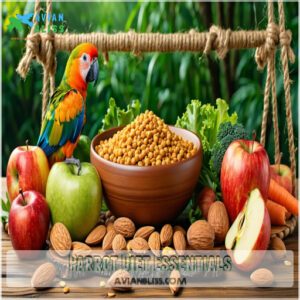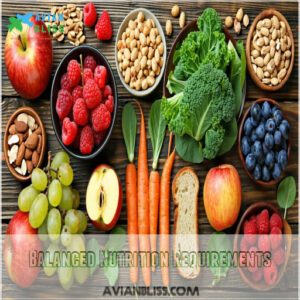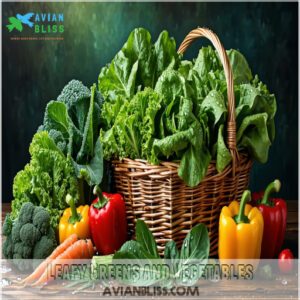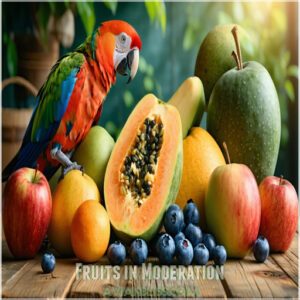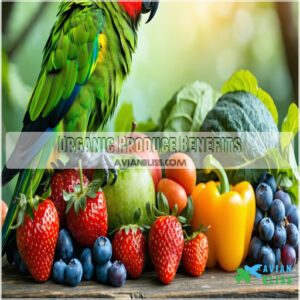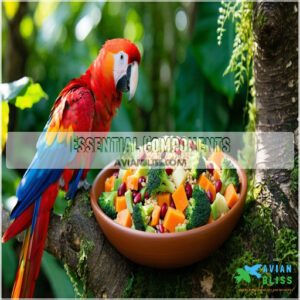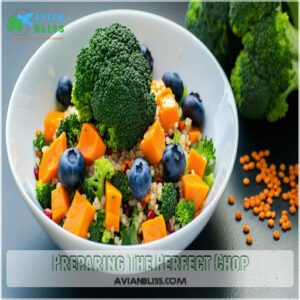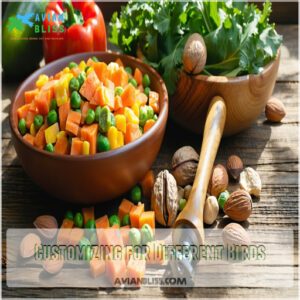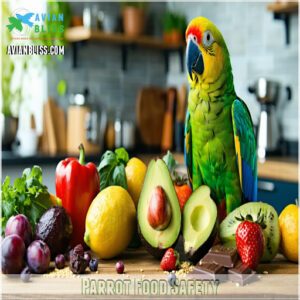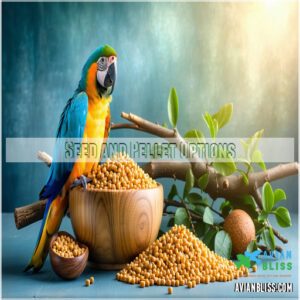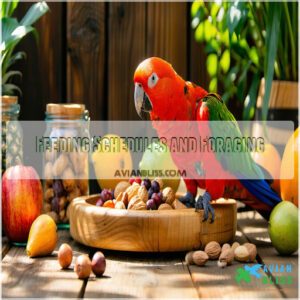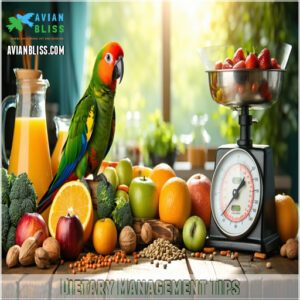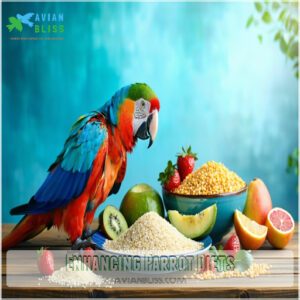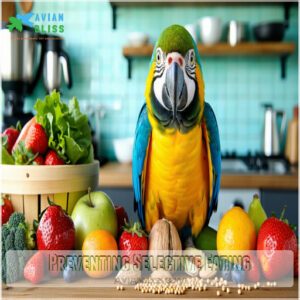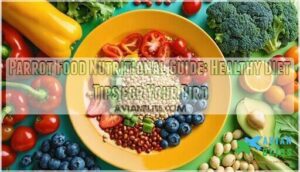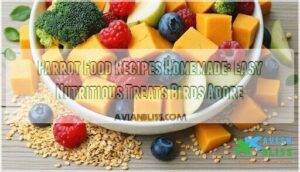This site is supported by our readers. We may earn a commission, at no cost to you, if you purchase through links.
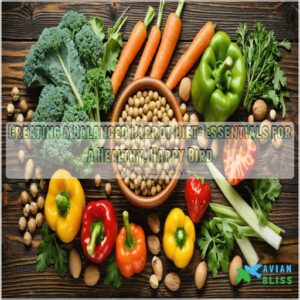
Start with high-quality pellets as your foundation, then add fresh fruits and veggies for essential vitamins. Think kale for calcium, carrots for vision, and bell peppers packed with nutrients.
While seeds and nuts might be your feathered friend’s favorite, they’re best served in moderation – think of them as parrot dessert! Just like us, parrots need variety to thrive.
Watch out for toxic foods like avocados and chocolate, which can be dangerous for your bird. There’s a whole world of nutritious options to keep your parrot healthy and chirping.
Table Of Contents
- Key Takeaways
- Parrot Diet Essentials
- Balanced Nutrition Requirements
- Fresh Foods for Parrots
- Creating Parrot Chop
- Parrot Food Safety
- Seed and Pellet Options
- Feeding Schedules and Foraging
- Dietary Management Tips
- Enhancing Parrot Diets
- Preventing Selective Eating
- Frequently Asked Questions (FAQs)
- What is a healthy diet for a parrot?
- How do you make your own parrot food?
- Should parrots have food all day?
- What do parrots like to eat the most?
- How long can prepared parrot chop stay frozen?
- Should parrot food be served warm or cold?
- When do baby parrots transition to adult food?
- Can parrots eat food meant for other pets?
- How often should vitamin supplements be given parrots?
- Conclusion
Key Takeaways
- You’ll want to make pellets the foundation of your parrot’s diet, while adding fresh fruits and vegetables to provide essential vitamins and minerals – treat seeds and nuts as occasional rewards rather than dietary staples.
- You can prevent selective eating by gradually introducing new foods mixed with familiar ones, and creating an engaging feeding experience through foraging toys and puzzles that mimic natural behaviors.
- You should feed your parrot twice daily (morning and evening) with properly portioned meals, monitoring their weight regularly to maintain optimal health and prevent obesity.
- You’ll need to avoid toxic foods like avocados, chocolate, caffeine, and alcohol while focusing on nutrient-rich options like leafy greens, colorful vegetables, and whole grains for a balanced diet.
Parrot Diet Essentials
You’ve got a hungry parrot, and it’s up to you to keep them healthy and happy with the right foods.
A balanced diet means focusing on high-quality pellets, colorful fresh produce, and just the right amount of seeds and nuts for variety and fun, which provides the necessary elements for a healthy lifestyle.
High-Quality Pellets
Choosing high-quality pellets ensures your parrot gets complete nutrition without relying solely on seeds.
Look for a variety of cold-pressed options free from additives. Here’s what to evaluate:
- Choose natural ingredients, avoiding dyes.
- Make sure balanced nutrients for essential health.
- Mix pellets for variety.
- Limit fatty seed supplements.
- Switch gradually to avoid diet shock.
Fresh Fruits and Vegetables
Fresh produce is key to a colorful diet for your parrot.
Try mixing veggies like carrots or leafy greens with fruits for birds, such as berries and papaya. Keep variety in mind for a nutrient-rich meal.
| Vegetables | Why It’s Great | Fruits | Why It’s Great |
|---|---|---|---|
| Kale | Calcium boost | Papaya | Rich in vitamin C |
| Carrots | Supports vision | Blueberries | High in antioxidants |
| Bell Peppers | Vitamin-packed | Apples | Hydrating and crunchy |
| Sweet Potatoes | Energy source | Mango | Natural sugars, vitamins |
Seeds and Nuts in Moderation
Seeds and nuts can be great snacks for your parrot, but keep portions small and balanced with pellet food.
They’re rich in healthy fats and crunchy textures birds love.
Remember these moderation tips:
- Offer variety: Rotate sunflower, hemp, and pumpkin seeds.
- Avoid overfeeding: Too many nuts can add excess fat.
- Monitor allergies: Watch for nut allergies or sensitivities.
Balanced Nutrition Requirements
A balanced diet is the key to your parrot’s health and happiness.
Parrots need nutrient-rich foods for proper growth, energy, and digestive health. Aim for a mix of proteins, healthy fats, and carbohydrates to cover their caloric intake.
Vitamin needs like A and C are essential for immunity and feather health, while calcium and magnesium support strong bones. Don’t skimp on iron-rich leafy greens or beta-carotene-packed carrots—variety prevents boredom!
Sometimes, mineral supplements can fill in gaps, but stick to what your vet recommends.
Think of parrot nutrition like building a colorful plate of goodness! A little planning provides balanced nutrition and keeps your bird chirping happily.
Remember, a healthy diet is more than food—it’s their way to thrive!
Fresh Foods for Parrots
Feeding your parrot fresh foods is one of the best ways to keep them healthy and happy.
From crunchy carrots to sweet blueberries, these colorful, nutrient-rich options keep mealtime exciting and nutritious.
Leafy Greens and Vegetables
Leafy greens are a parrot’s best friend! Packed with Green Nutrition, they boost your bird’s health.
Try these leafy delights:
- Kale Benefits: Rich in vitamins A and K.
- Spinach: Great for bones—just limit portions.
- Bell Peppers: Colorful, nutrient-rich veggies.
- Carrots: Crunchy vitamin A powerhouses.
Remember, Fresh Harvest veggies make your parrot’s diet nutrient-rich and balanced!
For ideal health, consider a parrot food guide to plan meals.
Fruits in Moderation
It’s fun to add fruits to your parrot’s diet, but they’re like dessert—keep portions modest.
Aim for variety: berries are antioxidant powerhouses, while tropical fruits like mango satisfy sweet cravings.
Avoid sugary overload with citrus fruits in moderation.
Here’s a quick guide:
| Fruit | Benefits | Caution |
|---|---|---|
| Apples | Crunchy, hydrating | Remove seeds |
| Mango | Tropical delight | Limit sugar intake |
| Blueberries | Antioxidants | Serve fresh and plain |
| Orange Slices | Vitamin C boost | Small amounts, avoid excess |
| Papaya | Digestive health | Remove seeds, serve fresh |
Organic Produce Benefits
Fresh fruits, leafy greens, and vegetables for birds are even better when you pick organic choices.
Why? Organic produce benefits your parrot with nutrient-rich foods free of harmful chemicals.
Here’s why pesticide-free, sustainable farming is worth it:
- Healthier nutrition: More vitamins and minerals.
- Safer eating: No chemical residues.
- Environmentally friendly: Protects nature, like a wingman for birds!
Creating Parrot Chop
Making parrot chop is a fun, simple way to pack your bird’s bowl with nutrients and variety.
By mixing fresh veggies, fruits, grains, and seeds, you can mimic their natural foraging diet while keeping mealtime exciting.
Essential Components
Creating the perfect parrot chop means focusing on vitamin needs, a good nutrient ratio, and mineral balance.
Start with fresh produce like kale, carrots, or broccoli for parrot nutrition.
Add protein-packed legumes, grains, and seeds for a balanced diet. Remember, variety keeps things exciting—no one wants the same salad every day, not even your bird!
A well-planned parrot diet should include daily fresh food sources to make sure your bird achieves the best health.
Preparing The Perfect Chop
Think of preparing bird chop like crafting a colorful salad—just bird-friendly.
Start with nutrient-rich ingredients like chopped kale, carrots, and quinoa.
Add variety with food rotation; mix in blueberries or lentils one day, broccoli the next.
Aim for a balanced diet by sticking to appropriate meal portions.
Fresh prep keeps parrot nutrition superior—and your feathered friend curious!
Customizing for Different Birds
You’ve prepped your chop—now tailor it for your bird’s size, age, and species-specific needs.
Small birds, like budgies, prefer finely chopped, softer veggies. Larger parrots, such as macaws, handle heartier grains and bigger pieces.
Beak shapes matter, too—cockatoos crack nuts easily, while smaller birds need seeds or grains.
Customizing guarantees balanced nutrition and keeps your parrot diet engaging and healthy! A balanced diet includes providing parrot food recipes to promote overall well-being.
Parrot Food Safety
Keeping your feathered friend safe starts with knowing which foods are harmful and how to avoid common feeding mistakes.
A little care, like skipping avocado and chocolate, can prevent big problems down the road!
Toxic Foods to Avoid
Watch out for toxic foods that can harm your parrot.
A few dangerous culprits include:
- Avocado: Toxicity causes respiratory and heart issues.
- Chocolate: Dangers like seizures or worse.
- Caffeine: Risks rapid heartbeats.
- Alcohol: Poisoning even in small amounts.
- Onions: Hazards include anemia.
To maintain a healthy parrot, it’s essential to understand parrot diet basics and avoid these harmful items.
Stick with safe foods and avoid these harmful items.
Common Dietary Pitfalls
Overfeeding or relying on high-fat foods, like seeds, leads to obesity and malnutrition.
Don’t fall into the trap of seed dependence—it’s a dietary mistake.
Nutrient deficits sneak up when sugary foods or toxic foods, like avocado, enter the diet.
Balance matters! Skip these pitfalls by offering variety, limiting portions, and keeping meals fresh and healthy.
Seed and Pellet Options
You’ve probably noticed that seeds and pellets are key players in your parrot’s diet, but striking the right balance is important.
While seeds are like candy to birds, high-quality pellets provide the balanced nutrition they need to stay healthy.
High-Quality Seed Mixes
Not all seed mixes are created equal! Choose ones with seed variety like chia, flax, and pumpkin for a balanced parrot diet.
Avoid low-quality fillers; go for human-grade, nutrient-rich options. Store seeds in an airtight container for freshness.
Rotate crops to keep it interesting, ensuring nutrient balance pairs with high-quality pellets. Your parrot’s food deserves thoughtful mix composition.
For ideal nutrition, consider using high quality seeds in your parrot’s diet.
Cold-Pressed Pellets Benefits
Cold-pressed pellets are a goldmine for your parrot’s nutrition! Unlike heated options, they retain nutrients essential for a balanced diet. Free from artificial junk, they keep things simple and wholesome.
- Rich in nutrients: Vitamins, minerals, and amino acids.
- Gentle processing: Cold pressing preserves nutrients better.
- Support variety: Pair with fresh foods for parrot nutrition.
The quality of cold-pressed pellets can be attributed to proper cold pressed manufacturing.
Your feathered buddy will appreciate the quality!
Feeding Schedules and Foraging
Feeding your parrot on a schedule and encouraging foraging keeps them healthy, happy, and entertained.
By offering meals twice a day and turning snacks into a foraging adventure, you’ll mimic their natural habits and make mealtime more fun!
Morning and Evening Meals
A balanced parrot diet thrives on a thoughtful feeding schedule. Start mornings with fresh, nutrient-rich chop—think veggies, grains, and a hint of fruit for variety.
Evenings? Opt for calmer foods like pellets or a light seed mix. Keep portion sizes in check to prevent overeating.
This meal timing guarantees proper parrot nutrition while satisfying their foraging instincts naturally. Understanding bird behavior feeding patterns is essential for creating a well-rounded diet that meets their nutritional needs.
Encouraging Natural Foraging
Keep your parrot entertained and healthy by encouraging natural foraging.
Use Foraging Toys and Food Puzzles stuffed with Hidden Treats to mimic wild behavior.
Sprinkle snacks around for Natural Exploration and create Environmental Enrichment opportunities.
This kind of foraging enrichment supports a balanced parrot diet, promotes parrot nutrition, and keeps your feathered friend’s brain sharp and body active!
Dietary Management Tips
You’ve got to watch your parrot’s portions to keep them healthy and full of energy.
Tracking their weight and adjusting meals as needed helps prevent obesity or malnutrition, so they stay their happiest, feathered selves.
Portion Control Importance
Regarding parrot feeding, size matters—meal size, that is!
Stick to proper portion sizes to avoid overeating risks and maintain weight management.
A balanced diet isn’t about stuffing the bowl; it’s about meeting daily nutritional needs.
Start small, then adjust the diet ratio based on your bird’s activity level.
Think healthy snacks, not birdie buffets!
Monitoring Weight and Health
Keeping your parrot at a healthy weight is just as important as a balanced diet.
Regular health checks help you spot changes early—watch their weight, feather condition, and even beak health. Sudden drops or gains? It’s a red flag.
Use monthly weigh-ins, aiming for a nutrition balance with nutrient-rich foods. A happy, healthy bird is worth the effort!
Providing a balanced bird diet is essential for maintaining ideal health and well-being.
Enhancing Parrot Diets
You can make your parrot’s diet more exciting and nutritious by adding whole grains and cooked legumes like quinoa or lentils.
These foods pack a punch with fiber and protein, helping your bird stay healthy and happy.
Whole Grains and Legumes
Whole grains and legumes are tasty, nutrient-rich additions to your parrot’s meals.
They’re packed with protein, fiber, and vitamins. Quinoa benefits your bird with extra protein and minerals!
Try these:
- Whole grains like quinoa, barley, or millet.
- Legumes such as lentils, mung beans, or chickpeas.
- Seed mixes with hemp or flax for variety.
A balanced diet requires understanding parrot food principles. Your feathered friend will love it!
Cooked Grains for Nutrition
If you’re looking to boost your bird’s nutrition, cooked grains are a fantastic choice.
Quinoa benefits include protein and amino acids, while cooked barley and brown rice provide fiber and energy.
Millet nutrition adds a light, nutrient-rich option.
Perfect grain prep means cooking grains until soft but not mushy—this makes sure they’re easy for your parrot to enjoy, with proper nutrition being key to their health.
Preventing Selective Eating
You’ve probably noticed that parrots can be picky eaters, tossing aside anything they’re not in the mood for.
By mixing up their meals and introducing new foods little by little, you can outsmart their selective eating and keep their diet balanced.
Offering Variety and Rotation
You’ll keep your feathered friend engaged and healthy by rotating their food options regularly.
Mix up nutrient-rich fresh fruits and vegetables with different textures and colors each week.
Combine familiar favorites with new options to maintain a balanced diet while encouraging natural foraging techniques – it’s like creating a mini buffet.
Your parrot gets excited about mealtime while getting complete nutrition.
Introducing New Foods Gradually
While maintaining a varied menu keeps your parrot engaged, introducing new foods takes patience.
Start by mixing small amounts of new ingredients with familiar favorites – your feathered friend’s more likely to try something new when it’s paired with trusted treats.
You’ll want to offer the same new food several times, as parrots often need multiple exposures before accepting dietary changes.
Frequently Asked Questions (FAQs)
What is a healthy diet for a parrot?
Want to keep your feathered friend healthy?
Your parrot needs a mix of pellets, fresh vegetables, fruits, and legumes daily.
Avoid seeds as the main diet, and you’ll have a thriving companion.
How do you make your own parrot food?
Create your own parrot food by mixing fresh vegetables, fruits, and grains into a nutritious chop.
Add pellets for essential nutrients, and include seeds in moderation.
Store portions in the freezer for convenience.
Should parrots have food all day?
Just as the early bird catches the worm, your parrot shouldn’t feast all day.
You’ll want to feed them twice daily – morning and evening meals – to match their natural eating patterns in the wild.
What do parrots like to eat the most?
Your parrot will go wild for nutrient-rich seeds, colorful fruits, and crunchy vegetables.
They’ll joyfully devour sunflower seeds, fresh berries, and sweet apples, but don’t let them overindulge in these tasty treats.
How long can prepared parrot chop stay frozen?
You’ll get the best quality from frozen chop within 3 months, though it can last up to 6 months.
Make sure to store it in airtight containers and label them with the prep date.
Should parrot food be served warm or cold?
Serve your bird’s food at room temperature.
While you don’t need to warm pellets or seeds, you’ll want to thaw frozen chop completely.
Cold food can upset your feathered friend’s digestion.
When do baby parrots transition to adult food?
You’ll need to move your baby parrot to adult food between 6-8 weeks after weaning.
Start by mixing formula with pellets, then gradually introduce fresh foods while monitoring their response and weight.
Can parrots eat food meant for other pets?
You’ll want to skip other pets’ food – it’s not designed for your feathered friend.
Stick to parrot-specific foods since cats, dogs, and other pets have different nutritional needs that won’t benefit your bird.
How often should vitamin supplements be given parrots?
You’ll rarely need supplements if your parrot eats a balanced diet of pellets and fresh foods.
Only add vitamins if your vet recommends them, usually for specific health concerns or deficiencies.
Conclusion
Picture your parrot’s plate as a vibrant canvas where you’re painting good health, one colorful ingredient at a time.
Creating a balanced parrot diet isn’t just about filling a bowl – it’s about nurturing your feathered friend’s wellbeing.
By combining quality pellets, fresh produce, and occasional treats, you’re setting up your companion for a healthy, happy life.
Remember, every bird is unique, so stay attentive to your parrot’s preferences while maintaining nutritional balance.
Your dedication to proper nutrition will reward you with a thriving, energetic companion.
- https://theparrotsocietyuk.org/site/index.php/parrot-information/pet-parrots/parrot-nutrition/feeding-a-balanced-diet-in-practice/
- https://www.unitedparrotkingdom.co.uk/all-articles/exactly-what-to-feed-your-parrot-all
- https://www.kaytee.com/learn-care/pet-birds/what-do-pet-parrots-eat
- https://www.featherbeautiful.com/en-us/blogs/news/the-ultimate-guide-to-creating-a-balanced-diet-for-your-parrot
- https://birdsupplies.com/pages/bird-food-feeding-your-parrot-a-well-balanced-diet

